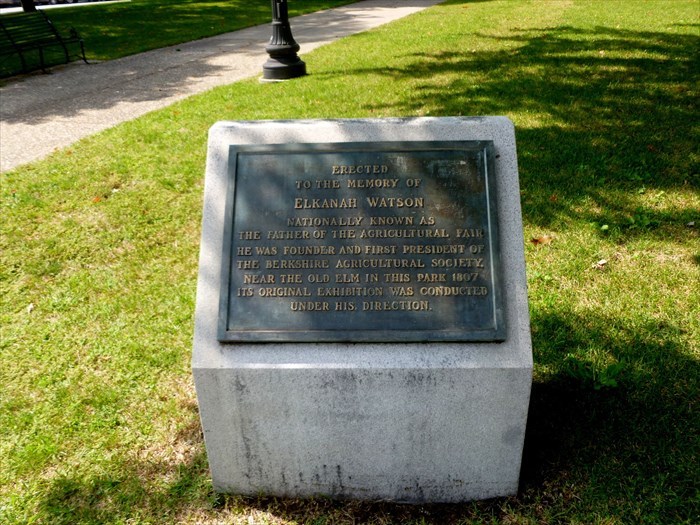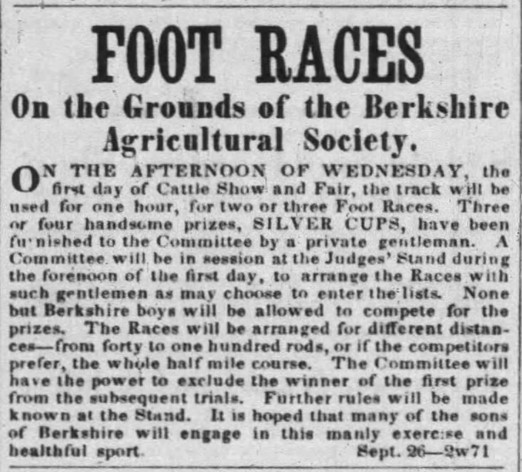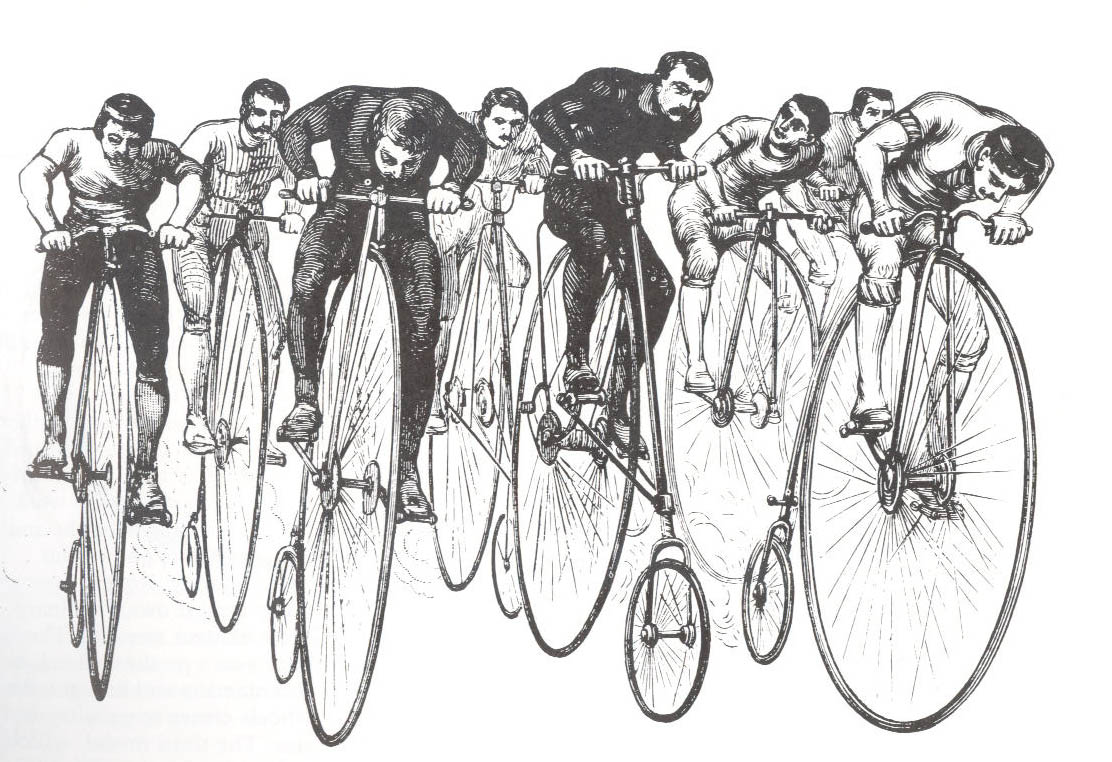The Beginnings of Racing in Berkshire County
Part III
Part III

(Source: Public Domain)
The 1855 Pittsfield Agricultural Fair
To complete our journey from the beginning to the uh…beginning…we have to make one last stop – at the fair!
Wait, what do cows and pickled vegetables have to do with racing in the Berkshires?
Relax.
The agricultural fair is a Berkshire invention. If that’s news to you, as it was to me, don’t worry. We will dive into that story later. For now, just understand that the multi-day exhibition of goods – wherein those goods were judged and pitted against one another for prize and prestige – was not a thing in 1800 Massachusetts. But in the early 1800s, following the example established right here in Pittsfield, state governments began to see that it was worth taxpayer dollars to fund and organize a degree of competition between agriculturists. This would serve to accelerate the state of the art, and help the young country catch up to its competition abroad.
It worked incredibly well. Each year, farmers and weavers, cooks and smiths would show up at the local annual fair with a better version of the cow/plow/shawl/pickle, hoping to win a respectable premium and some free advertising for their business. Thousands of spectators would see the innovations, and apply them to their own work, leading to compounding improvements for the next year. Thus, the technology of American farming and crafting improved rapidly during this time. County fair-driven innovations began paying dividends that would eventually lead to the industrial revolution, with America right on the leading edge. Go America!
Of course, every type of racing we know today owes a debt of gratitude to the industrial revolution, but that isn’t the point of this tale.
The point is that the fairs themselves were a spectacle to behold – not just for those participating, but for the paying visitors. Fairs were the ancestors of the amusement parks we know today. People travelled from far and wide to see them, and they expected a show. So, while the exhibitions at fairs were designed to advance the state of the art in agriculture, other entrepreneurs were finding ways to advance the state of entertainment. The fair was just the perfect stage.

(Source: Ebedilla, via Wikimedia Commons)
On that note…
In 1855, the Berkshire County Agricultural Society’s Cattle Show and Fair moved from downtown Pittsfield to a new dedicated fairground on upper Wahconah St. The new fairground included something that was not possible downtown - a half-mile dirt track for the exhibition of horses. The track was built under the premise that horses needed to be judged for their abilities to pull, prance, trot, pace, and whatever else horses do, and needed a HUGE grandstand to hold the thousands who would want to witness it. But we all know the real reason. Even in the 1850s, gambling was an irresistible business venture for the shady businessman, and horse racing was gaining popularity to the south. So, nudge after nudge, fairs started including “trials of speed” in the exhibition of horses. This was a fine line to tread, especially in Massachusetts, where racing horses (as well as wagering on them) had been illegal since 1846. And the argument that breeding racehorses had anything to do with the advancement of agriculture was an equally tenuous proposition.
The First Horse Races
It was Wednesday, October 4th, 1855. Day 2 of the fair. It was to be the first day of horse racing on a dedicated racecourse in Berkshire County history, and mother nature must have been tipped off because…it rained. Hard. It rained the day before and it rained even harder the day of the races. The track was a muddy mess by the time the trials were set to begin. The few competitors who bothered to show up ran one horse or team at a time around the track, slogging through the mud and standing water.
Times were recorded and results tallied, even though it was clear that this was not going to be a good show for anyone. The best half-mile time was 1:40 by a tandem of horses in harness, and the best full-mile time was 3:13 by a racking pony. We haven’t (yet) discovered the names of the horses or the owners. The official time trials were pushed to Friday on account of the weather, but the fair committee did award $10 to a Mr. John Prio of South Adams for “fair and liberal driving” of his trotting horses in the extreme weather conditions.
On Friday under sunny and bright skies (and over a soggy track), the real event was held. The format was a best-of-three in 1-mile heats. There were four horses entered, and it was a bay horse named ‘Charley’, owned by William O. Curtis of Lenox and trained by a Mr. Bright of Adams who won. Charley put up a time of 3.10 in the first mile heat, and 3.07 in the second. These were considered very good times for the condition of the track.
Of note, a group of “private gentlemen” (as they are called in the Pittsfield Sun) arranged and financed the races, independently of the fair committee. These folks saw the potential in the races, and immediately announced another meet to be held the following week. Right or wrong, they would be the first example of private race promoters in the county.
The First Foot Races
The story of the 1855 fair doesn’t end there.
The day before the rained-out trotting races occurred, on Wednesday, October 3rd as well as Friday, October 5th, the damp track was used for some good old muddy foot races. My opinion is that the foot races were a gimmick to keep people in the grandstands between horse races, as well as quell the concerns that the fair was supportive of illegitimate horse racing. It wasn’t meant to be a serious competition but given how much of a letdown the horse racing was, the foot races drew a huge crowd and ended up providing equal – if not better – entertainment than the horses did.
The advertisement in the Pittsfield Sun reads as follows:

(Source: Pittsfield Sun, Sept. 26, 1855)
The foot races earn the designation of the earliest documented race in Berkshire County (so-far). The Pittsfield Sun reported that the foot races “added much to the interest of the occasion”. They also published results, and thus earn the designation of the first documented race results in Berkshire County:
Day 1: October 3, 1855 (rain)
- First Race: Best of two half-mile heats, 3 competitors. Silver Cup valued at $8 won by Alfred Johnson of Pittsfield.
- Second Race: Best of two half-mile heats, 7 or 8 competitors. Silver Cup valued at $10 won by C.C. Lane of Lenox with times of 2:32 and 2:38 (pretty good for a muddy horse track in the rain).
- Third Race: Quarter-mile,$6 cash prize, won by D. Bardwell of Richmond.
Day 2: October 5, 1855 (sunny and bright)
- Fourth Race: Best of two half-mile heats, 7 competitors. Silver Cup valued at $12 won by Owen Leonard “an Irishman”.
- Grand Race: 1-mile single heat, 10 competitors. Silver Cup valued at $18 won by Milton G.Powers who ran a time of 5:30.
- A final quarter-mile sweepstakes was run to end the event, won by F. Wells.
The Sun reported that:
“As the competitors started on the last race, a colored boy, an amateur, 12 years old, and small ofhis age, named Montgomery (son of William Montgomery,) without any arrangementfor his competing, joined in the race, and would have come out “ahead of the lot,” it is said, had he not been pushed from the track. He ran nearly the entire circuit of a half mile, keeping ahead of all the competitors. The sum of five dollars was given him by the spectators who were delighted with his agility.”
A later report by the Berkshire Eagle reported a slightly different story, in which the $5 “was placed in the hands of Sheriff Marshall Willis, who judiciously expended it in clothes for the boy.”
All premiums awarded at the foot races were contributed by George W. Campbell, Esq. of Pittsfield, president of the Agricultural Bank. Mr. Campbell is thus Berkshire Racing’s first race sponsor of record. It is not clear if Mr. Campbell was also one of the “Private Gentlemen” responsible for the horse races.
The Beginning

(Source: www.theracingbicycle.com)
So for now, 1855 is the start – the REAL beginning – of recorded race history in Berkshire County.
Future articles will chronicle the second half of the 19th century, when the boom of racing followed the trajectory of the industrial revolution. Contraptions like downhill skis and bicycles started to be produced using standard parts and metals, and with more precision, reliability, and ease-of-use than their earlier wooden and hand-made prototypes. And of course, it didn’t take long for people to throw an internal combustion engine on those things, making a bike into a motorcycle, a carriage into a car, or even skis into a snowmobile! But those are stories for another day.
For now, here is the are the current oldest mentions I have yet found for each type of racing in Berkshire County.
October 3, 1855: Footraces at the Berkshire Fairgrounds around the half-mile horse track (held by the Berkshire Agricultural Society Fair)
October 5, 1855: Horse racing at the Berkshire Fairgrounds around the half-mile track (held by the Berkshire Agricultural Society Fair)
August 12, 1880: Bicycle racing at the Hoosac Valley Fair in North Adams.
July 4, 1903: 1-mile motorcycle time trials at the Berkshire Pleasure Park (Pittsfield Independence Day Celebrations)
July 4, 1903: 1-mile automobile time trials at the Berkshire Pleasure Park (Pittsfield Independence Day Celebrations)
August 14, 1908: Point-to-point balloon race, starting in North Adams.
March 10, 1915: Ski race between some young boys down Hoosac mountain from Whitcomb Summit to the village at the eastern portal of the Hoosac Tunnel.
February 22, 1920: Snowshoe and Nordic ski races in Williamstown (held by Williams College Outing Club). Skijoring is also mentioned (horse racing in snow).
January 13, 1963: Snowmobile races up and down Greylock from North Adams (held by The Spruces Club)
As Berkshire Racing grows and collects more information, we will present in-depth histories of each individual sport. For now, I challenge anyone with knowledge of any of these sports to come up with earlier examples of racing in the county – and let us know about it so we can update this list!
Sources
- Various archived papers via Newspapers.com, including the North Adams Transcript, The Pittsfield Sun, the Berkshire County Eagle as follows:
- Pittsfield Sun, 19 May 1831 – Rules about early agricultural fairs and attempts to limit competition without agricultural benefit.
- Pittsfield Sun, October 11, 1855 – Account of the 1855 fair
- Berkshire County Eagle, October 12, 1855 – Account of the 1855 fair
- Berkshire County Eagle, August 12, 1880 – First bicycle race
- Pittsfield Sun, July 9, 1903 – First motorcycle and automobile races
- North Adams Transcript, Aug 15 1908 – Balloon Race
- North Adams Transcript, March 10, 1915 – Ski Race
- North Adams Transcript, Feb 20, 1920 – Snowshoe Race
- North Adams Transcript, Jan 14, 1963 – Snowmobile Race